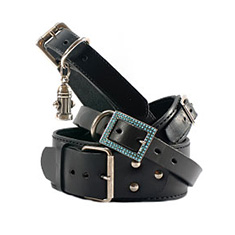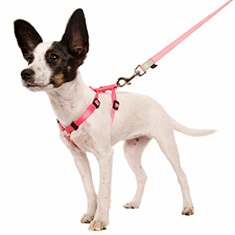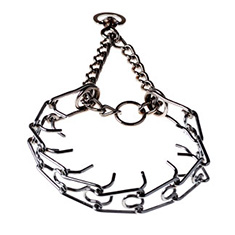Choosing the Right Collar and Leash for Your Dog
There are two important components to dog-walking equipment: a sturdy collar or harness, and a good leash or lead. Your choices will be informed by your dog’s size, energy level, and obedience aptitude, as well as by your own personal preferences.

One of the fundamental decisions you will make is whether to buy a collar or a harness. A harness typically wraps around a dog’s chest and forelegs, distributing the force from the leash over the top half of the dog’s body, rather than centering it on the animal’s neck. Harnesses are important primarily for smaller dogs whose windpipe may be compromised by a collar during a boisterous walk. Harnesses may also help stop your dog from pulling on the leash and taking you airborne.
Another option is the head collar, which wraps around the dog’s muzzle and neck. When you pull on the leash, the head collar puts light pressure on the dog’s muzzle and the back of the neck, just as a mama dog would when training her puppies. This light pressure establishes you as the pack leader, and helps the dog learn to follow you rather than lead you while on a walk.
If you have a small dog or if you have a dog who is a puller, you might choose a harness or head collar. Otherwise, your dog will likely do well with a conventional collar, but you still have many choices to make for functionality as well as style. Collars are generally classified by their function and by the material from which they are made.
Many people (and their dogs!) like a simple buckle collar, which is a strip of material with holes punched in it to accommodate the pin of the buckle attached to one end. For puppies who are still growing, a buckle collar is a natural choice, because it can be adjusted as the puppy grows to adulthood. Buckle collars may come in leather or nylon. Nylon is preferred if your dog will be spending any time in water, and leather may be better for dogs who chew through everything they see.
For ease of use, many people prefer that the collar be fastened by a clasp rather than by a buckle. Clasp collars are basically the same as buckle collars, but they close in one easy click (similar to a seatbelt), which is easier than having to make your dog stand still while you fasten a buckle. Clasp collars are typically made of nylon and are adjustable by means of a portion of the collar which is folded back on itself through the clasp.
Nylon collars come in a wide variety of fashion choices, including different colors and patterns, or they may have an assortment of beads or jewels embedded in the nylon. Sporting dogs may wear nylon collars in bright orange which makes them more visible to hunters. Beads and jewels may also be embedded in leather collars for those fancy occasions when a plain collar just won’t do.

Training collars, also known as choke chains, are often used for training. A short tug on the collar can get your dog’s attention when you give a correction. A choke collar must be put on and used correctly, so make sure you know what you are doing before you use one. Choke chains should not be your dog’s everyday collar, but should be used only during training sessions. Dogs should never be tied out on a choke collar due to the very real possibility that they will choke themselves.
A variant of the choke collar, the prong collar, is somewhat controversial. These metal collars have prongs that dig into the dog’s neck when a correction is given. Although they don’t cause physical harm when used correctly, they do cause some measure of pain. They can also become easily entangled in a dog’s fur, particularly on long-haired breeds.
No matter what type of collar(s) you choose, make sure that each one has a D-ring on it so you can attach the dog’s tags including registration, rabies, and identification.
As far as sizing, your collar should fit tightly around your dog’s neck so that only two fingers can be inserted between the dog’s skin and the collar. Any looser, and the dog may slip out of the collar; any tighter and he or she may choke. Tight collars may also cause hair loss and red, irritated skin. Check your dog’s neck frequently to make sure the collar still fits as the dog gains or loses weight.

Drs Foster and Smith offer more advice on choosing the right collar for your dog.
Leashes
As with collars, leads and leashes come in a variety of styles and materials. The most commonly used materials are nylon, leather, metal chain, and retractable cable. There are also leashes made from recycled materials and from a reinforced elastic material that is meant to prevent pulling. Your choice will be based primarily on personal choice; however, you must make sure the leash is strong enough for you to keep your dog under control. The bigger the dog, the wider the leash should be.
Leashes come in different lengths to serve different purposes. For your average walk, a leash of four, six, or eight feet will do just fine, allowing the dog to do at least some exploring, while keeping him or her under your control. With your dog walking at your side, you should be able to have the leash hang loosely from your hand to the dog’s neck without touching the ground. This length will obviously vary depending on the difference between your height and the dog’s height. Some leashes come with a handle sewn in the middle of the leash to allow you to hold up the excess length to keep the dog from tripping over the leash.
Retractable leads sometimes extend to as long as 30-feet which can be valuable when you are teaching your dog to stay. It allows you to be a fair distance from your dog while still keeping the animal from bolting. When you want to keep your dog closer to you, simply push a button on the retraction housing, and the excess length is rolled up. You can then lock the roller mechanism when the desired length of cable is retracted.
Chain leashes are not recommended because they can easily become entangled in the dog’s fur.
If fashion dictates that you just have to have a bedazzled leash, make sure the gems and jewels are sewn in securely so the dog doesn’t chew them off and choke on them.
The PetSmart website offers more advice on choosing the correct leash for your dog.
Doggies Den: Latest Articles
 Homemade Thanksgiving Treats for Your Dog
Homemade Thanksgiving Treats for Your Dog
NUTRITION We all want to include our dogs in our holiday celebrations, but hopefully, you're aware that sharing table scraps with your dog isn't always the best idea.
 Keeping Your Dog Safe during the Summer Months
Keeping Your Dog Safe during the Summer Months
HEALTH Summer is coming on fast, so it’s time to plan how you will keep your dog safe and healthy through the lazy, carefree, warm days.
 Vaccination Time Again-Keeping Your Puppy Healthy
Vaccination Time Again-Keeping Your Puppy Healthy
DOG HEALTH So you have your new puppy picked out. There are quite a few shots, treatments and examinations that will keep the newest member of your family healthy.
 Canine Thanksgiving Feast
Canine Thanksgiving Feast
NUTRITION With the wide variety of food at Thanksgiving dinner, chances are you'll want to give your dog something special, too. If you're contemplating what to feed your dog for the holiday, here is a guide to a great Canine Thanksgiving Feast.
 Dog Walking Tips Every Owner Should Know
Dog Walking Tips Every Owner Should Know
DOG FUN Walking your dog is not only crucial to keeping him healthy and happy, it strengthens the bond between your canine friend and his caregiver. There are a lot of obstacles out there. Don’t forget these simple tips to keep your walk fun and safe in the outside world.
 The Benefits of Physiotherapy for your Dog
The Benefits of Physiotherapy for your Dog
HEALTH The same techniques that physiotherapists use to treat a variety of injuries and conditions in humans have been adapted to suit animals with great success. Family pets, show dogs, and working dogs can all benefit greatly from physiotherapy. Dogs whose activities involve a lot of agility are especially susceptible to the types of problems that physiotherapy can address.
 The Decision- Adding a Dog to Your Family
The Decision- Adding a Dog to Your Family
FIRST TIME OWNERSBringing a dog into your family is a decision where many people don’t realize it’s magnitude until after they have the dog. There are a number of things that you need to research before you decide to purchase a dog, and it starts right in your own home.
 Bringing Your Dog Into Your New Baby's Life
Bringing Your Dog Into Your New Baby's Life
HEALTH Many believe that a dog and a new baby cannot happily coexist, so therefore the dog has to go. This is not necessarily the case.  A new baby does not mean you have to abandon your dog.

Doggies Den:
Most Popular Articles

Dog Pregnancy Symptoms
HEALTHIf you suspect your dog might be pregnant, check out part one in this series on pregnant dogs, where we cover pregnant dog symptoms.

Dog Birth
HEALTHIn the third article of our dog pregnancy series, we look at the wonderful, but messy, process of bringing newborn puppies into the world.

Indoor Dog Potties
DOG PRODUCTSIt's been a long day at work. You were so busy, you didn't even take time to eat a sandwich, let alone run home to let your dog out. You're on your way home, knowing the poor dog is crossing his or her legs by now, when your car breaks down, delaying you even further. Can't somebody make this easier?

Your Dog’s Digestive System
PHYSIOLOGYEver wonder why your dog eats so fast? Or why he eats gross things? Or why he gets sick to his stomach? Or why his waste stinks so bad? Some of these things are normal, some are not.

Canine Respiratory System
BREATHINGThe basic function of your dog's respiratory system is to bring oxygen in to and remove carbon dioxide from the body. Knowing the symptoms of respiratory diseases can help you help your stay healthy.

Shelter Dog Adoption Tips for Success
ADOPTION Are you intimidated by the prospect of "rescuing" a dog from a shelter? One reason that you may be wary of adopting a dog from a shelter is not knowing how to choose. Adopting a dog from a shelter can be a rewarding process, if you're prepared to do a reasonable amount of research.

Canine Urinary Tract Infections
SYMPTOMS AND TREATMENTDoes your dog seem to be having trouble relieving his or her bladder? Learn how to recognize the signs of urinary tract infections and how to treat them before they spread.

What to do for Dog Diarrhea
SYMPTOMS AND REMEDIESIf you have dogs in your house for any length of time, you have likely experienced at least one bout of dog diarrhea. Beyond the pain in the tuckus involved in cleaning up the mess, you should know what causes diarrhea, and when it's important to see the vet.

What to do for a Dog Bite
DOG BEHAVIOR Getting bitten by a dog can be scary, and you may be tempted to run around in circles for a while, trying to figure out what to do. Here's our guide to help you manage the situation.

Top Ten Tips for Living with a Senior Dog
DOG HEALTH Bringing home a new puppy is so exciting, but it doesn’t take all that long for your exuberant puppy to grow into a senior dog who may have special needs. Here are the doggies.com top ten tips for taking care of your companion who has been with you through so much.
